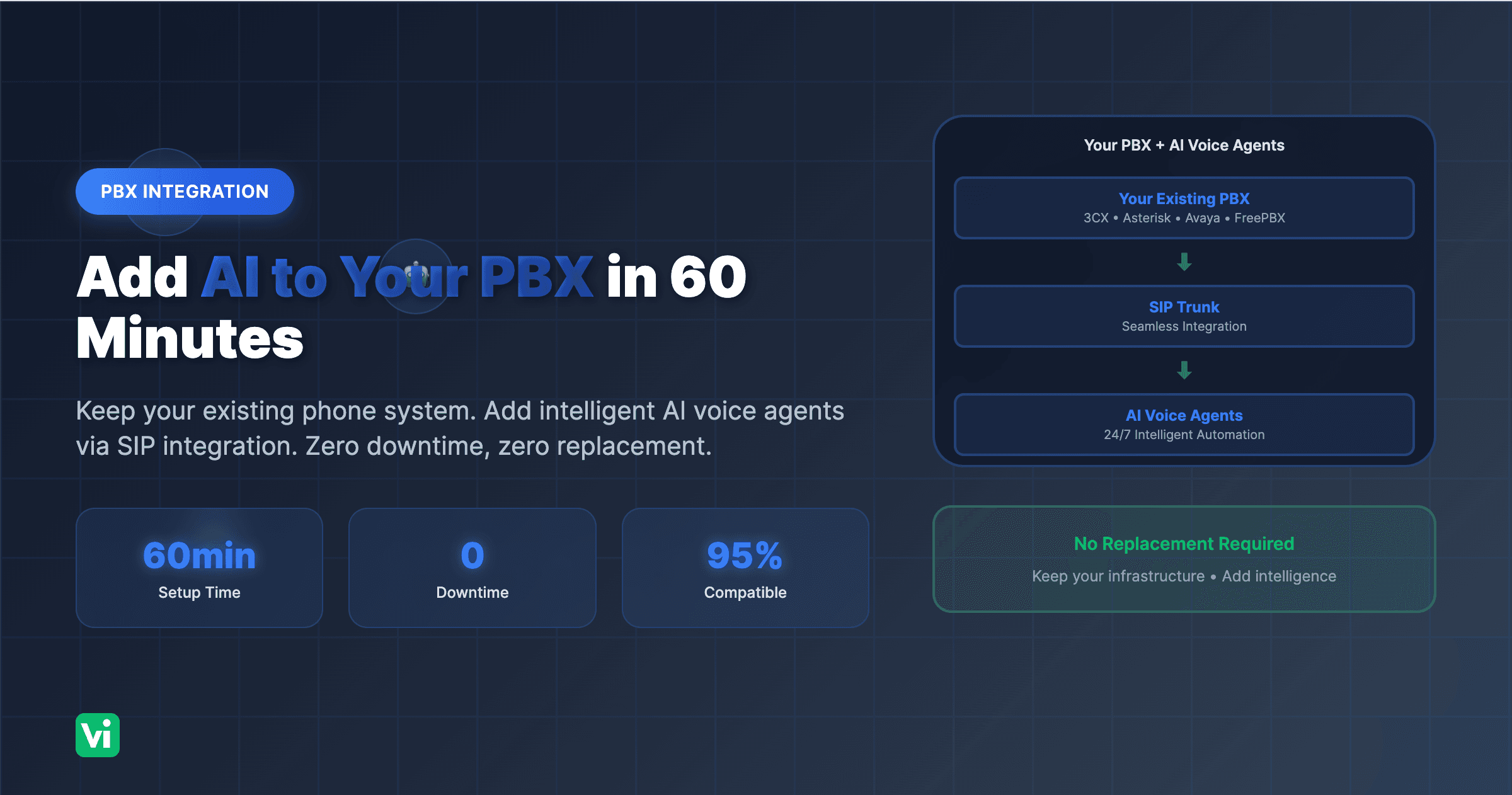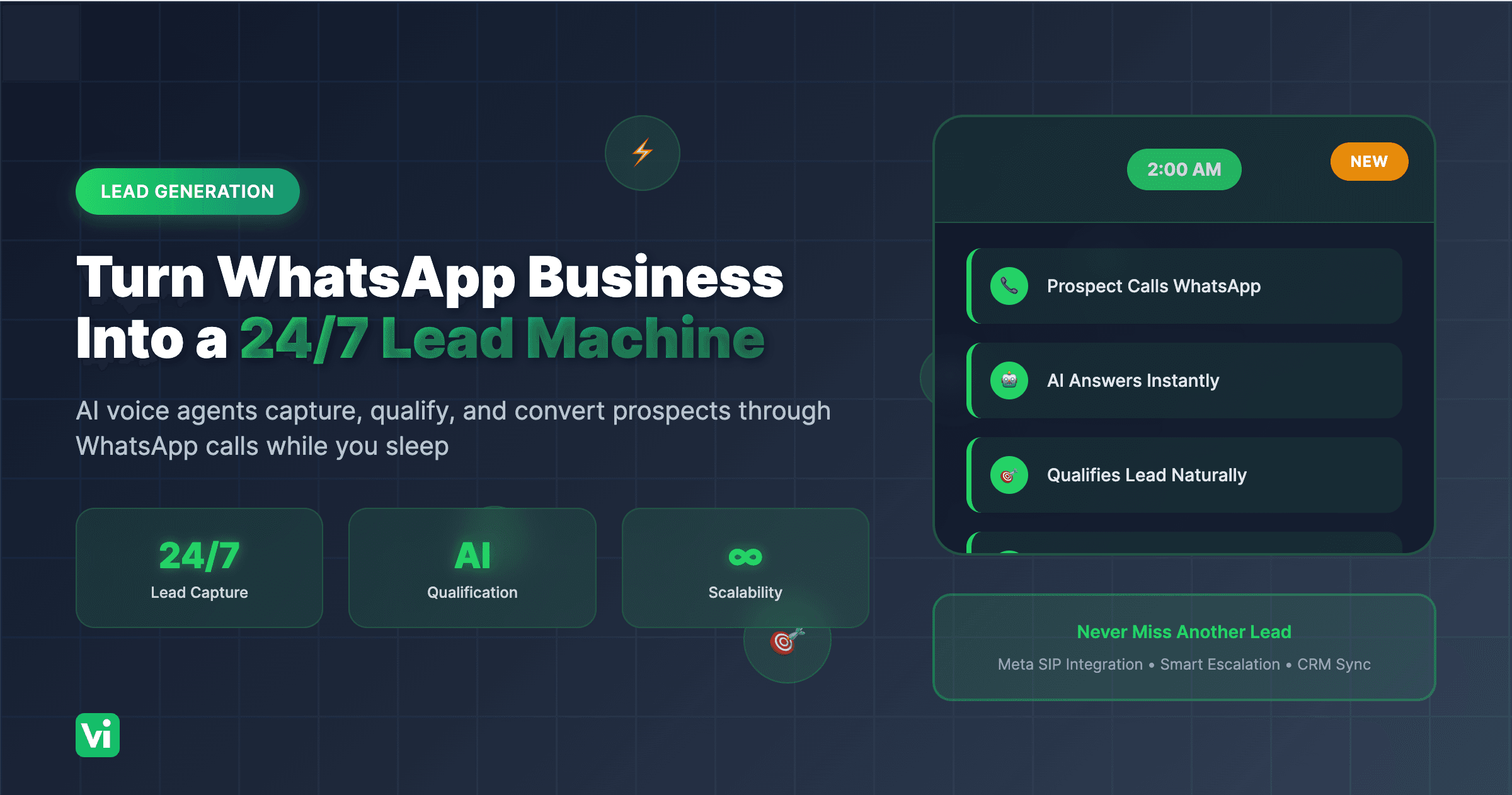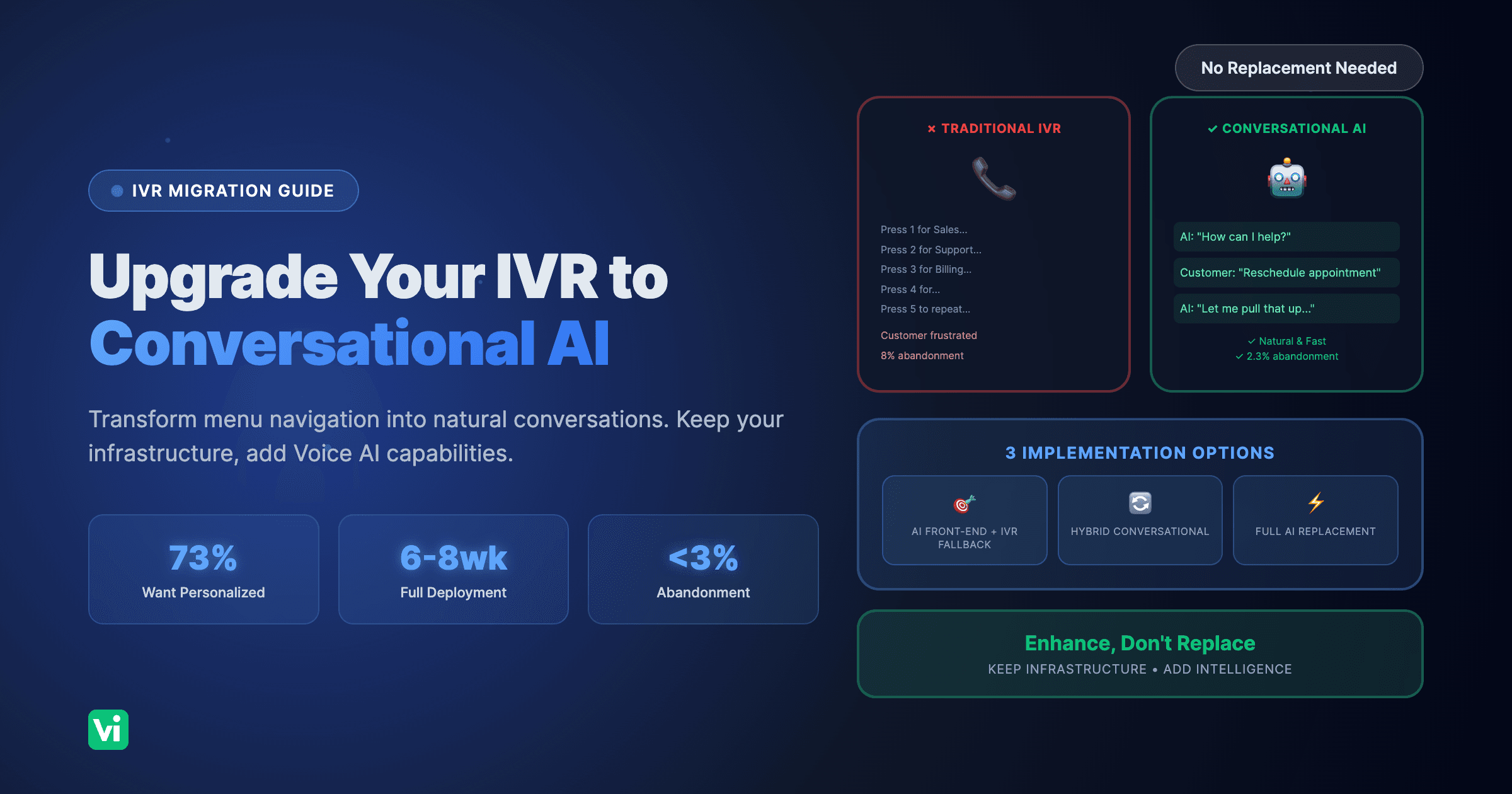Your expensive PBX system is bleeding money.
Every missed call during lunch. Every customer is stuck in phone tree hell. Every after-hours opportunity that goes to voicemail. Your expensive business phone infrastructure has become a revenue bottleneck instead of a growth engine.
Here’s what most businesses don’t realize: You don’t need to rip out your entire phone system to get AI-powered customer service. Your existing PBX can become an intelligent revenue machine in under 60 minutes.
The breakthrough: SIP integration enables you to add AI voice agents to any business phone system without replacement, downtime, or significant costs.
The Hidden Cost of Outdated PBX Systems
What Your Current System Is Actually Costing You
Direct Revenue Loss:
Average call abandonment rate: 5.91% with 3+ minute hold times (Global Contact Center data)
35% of business calls happen after hours - most going to voicemail
Each second of latency reduces customer satisfaction by 16% (industry research)
Missed calls represent lost opportunities that competitors capture
Hidden Operational Costs:
Staff productivity drain: Significant time spent on repetitive questions
Transfer inefficiency: Multiple transfers are common for complex calls
Training overhead: New staff require weeks to become productive
Inconsistent service: Variable quality depending on agent availability
Why Traditional Solutions Don’t Work
Option 1: Complete PBX Replacement
Cost: Significant investment for a new cloud system
Downtime: Extended periods during migration
Risk: Potential service disruption during transition
Learning curve: Staff retraining on the new system
Vendor lock-in: Forced into a specific provider ecosystem
Option 2: Hire More Staff
Cost: Substantial annual costs per additional staff member
Limitations: Still limited to business hours
Scalability: Can’t handle sudden call spikes
Quality: Inconsistent service during busy periods
Overhead: Benefits, training, management complexity
Option 3: Accept the Status Quo
Missed opportunities: Competitors capture your after-hours leads
Customer frustration: Poor experience damages brand reputation
Revenue leakage: Quantifiable losses every month
Competitive disadvantage: Falling behind businesses with modern solutions
The Smart Alternative: PBX AI Integration
Why Integration Beats Replacement
Keep Your Investment: Your existing PBX system represents a significant infrastructure investment. Modern SIP integration lets you enhance rather than replace, protecting your technology investment while adding cutting-edge capabilities.
Zero Downtime Deployment: Unlike system replacements that require weeks of downtime, AI integration happens alongside your existing operations. Your business continues running normally while AI capabilities are added seamlessly.
Gradual Enhancement: Start with basic automation and expand capabilities over time; no need for massive upfront changes or staff disruption. Add intelligence incrementally as your team adapts.
How SIP Integration Transforms Legacy PBX Into an AI Powerhouse
The Technical Process:
Incoming Call → Your PBX → SIP Trunk → AI Voice Agent → Smart Routing
What Happens:
Call arrives at your existing PBX system normally
SIP trunk routes specific calls or extensions to AI agents
AI agent answers with natural conversation capabilities
Smart decisions made in real-time: answer, transfer, or escalate
Seamless handoffs to human staff with full conversation context
Compatible PBX Systems:
3CX: Full SIP support, straightforward configuration
Asterisk: Open source flexibility, custom configurations
Avaya: Enterprise features, advanced routing capabilities
FreePBX: Cost-effective integration, community support
Cisco: Premium integration with an extensive feature set
Yeastar: Modern IP-PBX with standard SIP protocols
Integration Requirements:
SIP trunk capability (standard on modern systems)
Available extension or DID number
Admin access to PBX configuration
Internet connectivity for AI processing
Step-by-Step: 60-Minute Setup Process

Step by Step guide on how to integrate VoiceInfra with your PBX
Step by Step guide on how to integrate VoiceInfra with your PBX
Phase 1: Assessment (15 minutes)
Verify SIP trunk capability on your PBX
Identify an available extension or phone number
Review current call routing patterns
Define which calls should go to AI vs humans
Phase 2: Technical Setup (30 minutes)
SIP Configuration:
Access your PBX admin panel
Create a new SIP trunk pointing to VoiceInfra servers
Configure authentication credentials
Assign extension or DID to an AI agent
Test connectivity
AI Agent Configuration:
Upload business information (website, policies, pricing)
Configure conversation flows and escalation rules
Connect integrations (CRM, scheduling systems)
Set voice preferences and personality
Define working hours and after-hours behavior
Phase 3: Go Live (15 minutes)
Test call routing and AI responses
Verify escalation procedures for human staff
Confirm integrations work correctly
Monitor initial performance and adjust as needed
Cost Considerations: Integration vs Replacement
Traditional PBX Replacement Approach
Cloud Migration Expenses:
New system licensing and subscription fees
Professional services and implementation costs
Hardware replacement requirements
Staff onboarding and transition time
Potential business disruption during migration
Ongoing Operational Costs:
Monthly subscription fees
Maintenance and support contracts
Vendor dependency and potential price increases
Limited customization options
AI Integration Approach
One-Time Setup:
VoiceInfra setup and configuration
SIP trunk configuration (minimal IT time required)
Business information upload and configuration
Testing and optimization
Ongoing Benefits:
Usage-based pricing scales with business needs
No vendor lock-in or long-term contracts
Keep existing infrastructure investment
Gradual capability expansion as needed
Key Advantages of Integration
Cost Efficiency:
Significantly lower upfront investment
Preserve existing infrastructure value
Avoid migration risks and downtime
Flexible scaling based on actual usage
Advanced AI Capabilities
Intelligent Call Routing
Intent Recognition: AI understands the caller’s needs and routes appropriately
Context-Aware Decisions: VIP customers, emergencies, and complex issues get priority handling
Smart Escalation: Seamless handoffs to human specialists with full context
Real-Time Integrations
CRM Connectivity: Customer information and conversation notes updated automatically
Business Applications: Calendar, inventory, order status, and payment systems
Workflow Automation: Appointment booking, lead qualification, and follow-up tasks
Emotion Detection
Sentiment Analysis: AI recognizes frustration, satisfaction, and confusion
Adaptive Responses: Conversation style adjusts based on customer emotional state
Performance Optimization: Track satisfaction trends and improve responses continuously
Frequently Asked Questions About PBX AI Integration
Can AI voice agents really work with my existing PBX system?
Yes, AI voice agents integrate with virtually all modern business phone systems through standard SIP protocols. This includes 3CX, Asterisk, Avaya, FreePBX, Cisco, Yeastar, and other SIP-compatible platforms. The integration uses your existing infrastructure without requiring hardware changes or system replacement.
How long does it take to set up AI integration with my current phone system?
Most integrations are completed in 30-60 minutes. The process involves configuring a SIP trunk in your existing PBX, assigning an extension to the AI agent, uploading your business information, and testing the connection to ensure it is working correctly. No downtime is required, and your existing phone service will continue to operate normally during the setup process.
What happens if the AI can’t handle a customer’s request?
The AI seamlessly transfers calls to the appropriate human staff with complete conversation context. The person receiving the transfer gets the full conversation history, customer details, and the specific reason for escalation. Customers never need to repeat their information or start over.
Will I need to replace my existing phone numbers or extensions?
No, you keep all existing phone numbers and extensions. AI agents can be assigned to specific extensions, handle overflow calls, or manage after-hours coverage. Your current phone system continues working exactly as before, with AI capabilities added alongside its existing functionality.
How much does PBX AI integration cost compared to system replacement?
AI integration typically costs significantly less than a complete system replacement. You avoid hardware costs, professional services fees, staff onboarding, and business disruption. The exact savings depend on your current system and requirements, but integration preserves your existing infrastructure investment while adding intelligent capabilities.
Can I start small and expand AI capabilities over time?
Absolutely. Most businesses begin with basic call handling and appointment scheduling, then gradually add more sophisticated features, such as CRM integration, advanced routing, and workflow automation. This approach minimizes risk and allows your team to adapt to new capabilities incrementally.
What types of calls work best for AI handling?
AI agents excel at handling routine inquiries, such as pricing questions, appointment scheduling, service area verification, basic troubleshooting, and lead qualification. Human specialists typically handle complex technical issues, emotional situations, and high-value sales negotiations with a complete understanding of the context.
Do customers realize they’re talking to AI?
Modern AI voice agents sound natural and conversational. Most customers don’t initially realize they’re speaking with AI. For customers who prefer human interaction, AI agents can instantly transfer calls to available staff while maintaining continuity of conversation.
How do I measure success after implementing PBX AI integration?
Key metrics include call abandonment rate, average response time, customer satisfaction scores, first-call resolution rates, and overall efficiency improvements. Track these metrics before and after implementation to measure the impact on your business operations and customer experience.
What if my PBX system is very old or uses proprietary protocols?
While most modern systems support standard SIP integration, older proprietary systems may require additional configuration to integrate with SIP. VoiceInfra’s technical team can assess compatibility and recommend solutions for virtually any business phone system, including legacy installations.
The Future of Business Phone Systems
The businesses that thrive aren’t replacing their infrastructure every few years; they’re enhancing existing investments with intelligent capabilities.
Your PBX system doesn’t need replacement. It needs intelligence.
AI integration transforms your current phone infrastructure from a cost center into a revenue engine. Keep your investment, eliminate limitations, and capture opportunities your competitors miss.
Ready to transform your PBX system into an AI-powered revenue engine?
Get started in 60 minutes:https://voiceinfra.ai/sales
VoiceInfra integrates with existing PBX systems, including 3CX, Asterisk, Avaya, FreePBX, Cisco, and other SIP-compatible platforms. Our AI voice agents enhance your existing infrastructure without requiring replacement, downtime, or incurring massive costs. Transform your phone system into an intelligent business asset in under 60 minutes.



